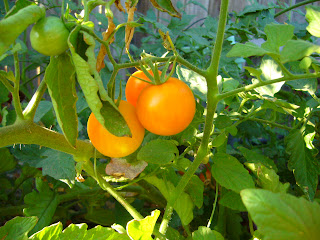Three more games... Three more games... Three more games... Three is the only number that I can think of today -- as my thoughts are occupied by the magic that is currently taking place at AT&T Park in the San Francisco Bay Area.
Three more games...
 |
| St. Clare Catholic Church, Roseville CA |
It wasn't all that long ago -- you understand -- October 26th, 2002 to be exact -- when the wonderful wife that is Venus said those magic words "I do" and started this magic journey of ours. "Watch Bill & Venus get married," we exclaimed. "Then watch the Giants take care of the Angels in Game 6 of the World Series during the reception and bring home a first-ever baseball championship to San Francisco."
Unfortunately -- as the rumor goes -- someone popped open a bottle of champagne a tad too early that night. The Giants would not win Game 6. They would eventually blow a 3-2 series lead by choking away Game 7 on the first night of our honeymoon cruise. There would be no joy in San Francisco. No championship. No party. Just missed opportunities.
As Frank Sinatra once crooned: "That's Life."
 |
| Hello Kitty Beehive |
Speaking of life -- there is something rather strange taking place in the Backyard of Bird at the moment. You can see it in the photograph to your immediate left. Yes -- that is the "Hello Kitty" beehive. And you'll notice that the bees are quite active today. That's a good thing. They're active every single day of the week. I've been gifted with a strong hive -- but that's another story for another day.
No -- what I'm referring too is that "volunteer" tomato plant to the right of the hive. It's doing something that I have never seen a plant do before. It is literally changing colors before my very eyes. It's not dying. It's just turning a bright shade of yellow. I'm not sure how. I'm not sure why. It just is.
 |
| Mystery Tomato Plant Turning Yellow |
I have never witnessed a tomato plant do such a thing before. Normally? Tomato plants start out green and remain green through the course of a growing season. They will yellow somewhat as the weather turns colder and the season comes to a close -- but that's the mark of death. I'm used to that.
No -- this is different. I have a healthy tomato plant that is turning a bright shade of yellow and I really can't understand why. It is also covered with a heavy crop of lacewings (I think that is what they are called) who gracefully move from leaf to leaf. There are scads of them -- as well as scads of tomato flowers -- but no tomatoes have formed on this plant yet (as far as I can tell).
I don't want to get too close to that "Hello Kitty" beehive you understand. It's late fall. Pollen sources are drying up. This is when honeybees tend to get defensive. They can -- and will -- reach out and "touch" you in ways you really don't like. So -- mind your manners young man.
There are some tomato plants -- some rare strains -- that do change colors during the course of a season. The father of the modern tomato -- Alexander Livingston -- wrote about one such plant in his 1893 book "Livingston and the Tomato." The name of this particular variety escapes me at the moment -- but the strain is very old -- and it's not counted as one of the "favorites" among heirloom growers.
I have never grown such a plant. I've heard of it in various publications. But I've never actually seen one in person.
Perhaps a smarter gardening mind than mine can figure this one out? I'm open to suggestions. I must tell you -- this plant is breathtakingly beautiful. It is a shimmering dark green. Based upon the number of flowers it is producing -- it appears to be some sort of cherry variety. But a tomato plant that turns a bright shade and healthy shade of yellow? That's a new one for me.
This is one of the many reasons -- I suppose -- why I like to grow heirloom tomatoes. Number one in my book -- of course -- is a love for all things tomato. I can't get enough of them. But it's also the surprises that tend to pop out of the ground every season.
 |
| Large Orange Cherry Tomato Plant |
One of those surprises that continues to do very well into the fall season is a surprise cherry variety that I call Large Orange Cherry. It appears to be some sort of cross between a Sun Gold Cherry (which I grew several years ago but have not planted since) and another larger variety. This thing popped up outside of a raised bed last year and produced a few large -- orange colored -- cherry tomatoes.
I did not seed nor save it. I was surprised to see it spring to life again -- on the other side of a large backyard. It has flourished in this place -- it's new home -- and this year I will make an attempt to seed and save a variety that refuses to die.
That's Life.








































